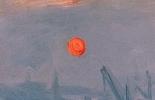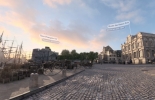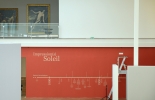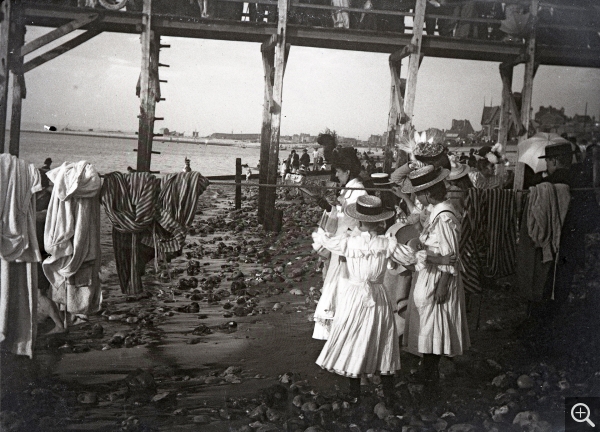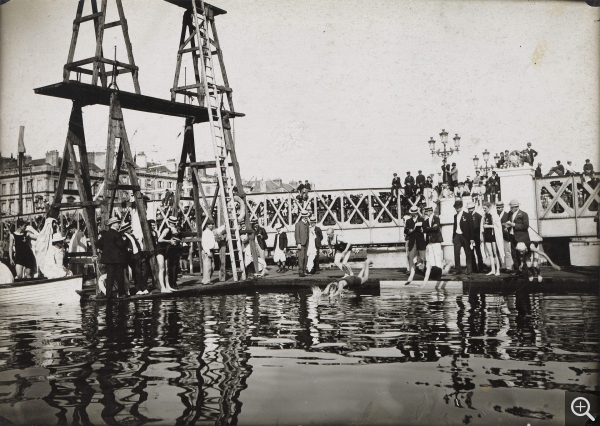Impression(s): Sun
from September 10 to October 08, 2017
But Monet is not the only artist who endeavoured to capture the light of Le Havre. Impression: Sunrise is the centrepiece of the exhibition “Impression(s): Sun”, which features around 30 works by five major artists from the nineteenth century and the early twentieth century: J.M.W. Turner, Gustave Le Gray, Eugène Boudin, Félix Vallotton and Raoul Dufy.
They all spent time in Le Havre, some before and some after Monet, and were intrigued by its bustling harbour setting, the changes it was going through and its differing lights. Looking east, towards the rising sun, Le Havre was a busy, thriving modern harbour. Looking west, towards the setting sun, the long curving beach allowed one to lose one's gaze in the contemplation of endless sea and sky.
They all spent time in Le Havre, some before and some after Monet, and were intrigued by its bustling harbour setting, the changes it was going through and its differing lights. Looking east, towards the rising sun, Le Havre was a busy, thriving modern harbour. Looking west, towards the setting sun, the long curving beach allowed one to lose one's gaze in the contemplation of endless sea and sky.



- Gustave Le Gray (1820-1884), Phare et jetée du Havre, 1857, Los Angeles, J. Paul Getty Museum. © digital image courtesy of the Getty’s Open Content Program
- Edouard Fortin, Le Bord de mer à Sainte-Adresse à marée haute, 1857 - 1858, Bibliothèque municipale du Havre, Collection SHED
- Bateaux sortant du port du Havre, avant 1861, Archives municipales du Havre
- Albert Wiltz, Le Grand quai, le Musée-Bibliothèque et l'anse des pilotes, Bibliothèque municipale du Havre
- Emile Wanhout (1863-1932), Scène de plage et bains de mer au Havre,1890/1910, Bibliothèque municipale du Havre
- Hôtel et Casino Frascati, avant 1899
- Georges Asselin, Le Havre, Bains Marie-Christine, vers 1900-1910, Archives municipales du Havre
- Noël (A.M), Cerf volant sur l'estacade de Sainte-Adresse, devant le Palais des régates, 1910, Bibliothèque municipale du Havre, Fond iconographique Philippe Manneville
- Charles Noël, Course de baquets à la godille au pied de l'estacade du Havre, 1900/1910, Bibliothèque municipale du Havre, Fonds iconographique Philippe Manneville
- Noël (A.M), Circuit des bassins, organisée par la libellule havraise, départ des nageurs dans le bassin du commerce, 1910, Bibliothèque municipale du Havre, fonds iconographique Philippe Manneville
- Jéhan Jean, Le Grand-Quai à marée haute, 1930, Bibliothèque municipale du Havre
- Jéhan Jean, Paquebots à quai, dont le paquebot Normandie, 1930, Bibliothèque municipale du Havre
Joseph Mallord William Turner (1775-1851)

Joseph Mallord William TURNER (1775-1851), Le Havre : Tour François Ier, vers 1832 pour Turner’s Annual Tour, 1834, , 14 x 19.2 cm. . © Tate, Londres, 2017
In Claudian Harbour Scene: Study for ‘Dido Directing the Equipment of the Fleet’, the composition, perspective and luminous ambience, with the setting sun placed in the centre of the picture, are a homage to Lorrain. This painting was a study for a large picture to be exhibited at the Royal Academy in 1828. The imposing backlit round tower may well have been based on his recollections of the Tour François 1er, which he would have seen in Le Havre on his trips to Normandy.
Turner visited Le Havre at least four times between 1821 and 1832. He lodged on the Grand Quai, where the steamers from Britain docked. During these stays, he made numerous sketches, concentrating chiefly on the old harbour district, which at that time was still overlooked by the Tour François 1er. It was the liveliest and most picturesque part of the city. Turner liked to sketch the to-ing and fro-ing on the docks and the brightly-coloured crowd at the harbour’s edge. He amassed more views of Le Havre on each visit.
In the early 1830s, the publisher Charles Heath decided to cater to the vogue for France among British travellers with three books about French rivers, illustrated with engravings based on sketches by Turner. The first (published in 1833) took the Loire as its subject, and the two others (published in 1834 and 1835) focused on the Seine. Under the title “Wanderings by the Seine”, the first of the two volumes devoted to the Seine featured locations between Le Havre and Rouen, while the second explored locations between Château Gaillard and the source of the river.
The book was structured as a journey up the Seine. It began with a view of the lighthouses of la Hève from the sea, used as a frontispiece, and continued with a view of Le Havre from the entrance to the channel and another from the crook of the outer harbour, looking towards the sea.
The designs Turner provided for Heath’s engravers were gouache and watercolour compositions produced in his studio on the basis of sketches he selected from his stock. He did not feel constrained to adhere to a strict topographical description of the sites. He had no qualms about turning the cliff of the la Hève headland into a more romantic elevated promontory or making the silhouette of the Tour François 1er bulkier and taller than it really was. Under his paintbrush, the hotch-potch of buildings along the Grand Quai became an orderly line of elegant façades. This distortion of facts did not go unnoticed, but the critics defended the liberties taken by Turner as fitting, accurate and ultimately the sole means by which the artist could give a convincing notion of the place.
His vision was also underpinned by a novel treatment of light. Turner uses watercolour and gouache to capture a wide range of atmospheric effects, and mimics Lorrain in structuring his compositions around a rising or setting sun positioned on the central axis. As with Lorrain, the time of day sets the overall tone of a picture - cool and bluish in the morning, golden and radiant in late afternoon. In these works, Turner gives us the first genuinely modern depictions of Le Havre.
Gustave Le Gray (1820-1884)

Gustave LE GRAY (1820-1884), Le Soleil au zénith – Océan n°22, Normandie, 1856, , 31.8 x 40.7 cm.
In 1855, Le Gray set himself up in a big studio at 35 Boulevard des Capucines, in Paris. Incidentally, it was in this very studio, which had by then been taken over by the photographer Nadar, that Impression: Sunrise was displayed in the first Impressionist exhibition in 1874.
Le Gray visited Le Havre in 1856, and probably returned several times between then and 1858. At a very early stage, Le Havre harbour inspired photographers like the Macaire brothers to take impressive landscape photographs, notably daguerreotypes. They succeeded in capturing the movement of ships and waves for the first time. It may have been the popularity of their pictures that persuaded Le Gray to visit the coast of Normandy.
There are a few urban scenes, but Le Gray’s preferred subjects are the sea, the beach and the cloudy sky lit up by the setting sun - subjects that were especially difficult to render using the medium of photography.
Le Gray was the first to use large plates (around 32 x 42 cm) to do justice to pictures he wanted to be spectacular. The shorter posing times afforded by the collodion process meant that some of his photographs successfully captured both sea and sky at the same time. This was a great achievement: until then, skies had usually been overexposed on account of the length of time required to take photographs.
To overcome this problem, Le Gray developed an innovative combination photography technique he called ciels rapportés. On the same proof, he would consecutively print complementary parts of two negatives - one for the sea or the beach, the other for the sky, choosing a sky with strong chiaroscuro effects that he had successfully photographed elsewhere. Seascapes particularly lent themselves to this process on account of their unbroken skyline. This process allowed Le Gray to obtain highly subtle effects that superbly convey every mood of the coastal weather.
Giving the lie to the accepted view that photography made it possible to capture a fleeting moment “objectively”, reducing the role of the photographer to that of a mere operative, Le Gray used a lengthy process to create the illusion of the perfect moment. But the landscape he delivers for our contemplation is sometimes a composite image pieced together from fragments of reality.
These photographs were exhibited in London and Paris, and brought their creator huge success. They sold in large numbers, and Le Gray received further official commissions. There is no proof that Monet saw the images, but he was a young painter working in Le Havre at the time of Le Gray’s visits, and it is very likely that some of Le Gray’s sensational prints were displayed or offered for sale in the windows of a photographer’s salon on the north jetty or a shop selling artists’ materials like the one where Monet met Boudin in 1858.
Eugène Boudin (1824-1898)

Eugène BOUDIN (1824-1898), Soleil pâle se couchant, ca. 1888-1895, oil on wood, 27.3 x 21.5 cm. © MuMa Le Havre / Florian Kleinefenn
He very soon showed a genuine talent for conveying atmospheric effects and cloud movements in pencil, pastels and oil paint. He kept a diary, in which he recorded his doubts and aspirations: his writings largely revolve around the sky and nature.
When a work of Boudin’s was exhibited in the Paris Salon for the first time in 1859, Baudelaire, who had visited the artist’s studio in Honfleur the previous summer, wrote less glowingly about the Salon picture than about the sky studies he had seen in the studio - “those astonishing studies, so quickly and accurately sketched, of what is the most inconstant, the most elusive in its form and colour”, “[t]hose gaping furnaces, those black or violet satin firmaments, crumpled, rolled or ripped apart, those horizons draped in mourning or streaming with molten metal…” Boudin clearly excelled at painting the sky and its effects at an early stage. But Baudelaire himself also wrote: “He knows that all this has to be made into a picture by means of poetic impression … and he does not have the pretention to present his jottings as pictures.”
Boudin did produce “pictures” - finished compositions - to meet the demands of art collectors and dealers. From the early 1860s, he settled into a pattern of work, spending the fine months in Normandy, painting outdoors and accumulating studies and impressions, and returning to his Paris studio, where he reworked his sketches and notes and prepared pictures to send to the Salon, from October onwards.
The city of Le Havre Boudin knew so well and continued to visit frequently inspired a great many of his pictures - over 200. Almost all of them are views of the harbour and its basins, chiefly painted from the level of the water’s surface, giving as much space to the sky as to the sea. His favourite views include the harbour exit, sometimes referred to as
the harbour entrance, which was very popular with art-lovers. He produced many versions of this subject in different lights and weathers - calm, blustery and stormy, and of course at sunset.
For Boudin, as for Turner and before him Lorrain, the sun is an integral part of pictorial composition, as he indicates indirectly in a letter: “When I got back [from Le Havre], where I had made several sketches of the harbour exit, I thought of placing the sun in the background. I liked the picture so much that I painted it ten times over, with its three-master and its sun.” (1882)
The way in which placing the sun low on the horizon could structure a composition led Boudin to take liberties with reality when he felt the picture needed it for the purpose of balance. For instance, he had hesitation in placing a sunset due south in the two views of the Bassin de l’Eure in this exhibition.
Towards the end of his life, Boudin’s work displays a renewed spontaneity, with pictures that are very freely executed and deliberately left as sketches. To some extent, they mark a return to the exploratory pastel sky studies of his beginnings. No longer feeling the need to finish his pictures, he recovers the “instantaneity” that was his great lesson to the youthful Monet.
Félix Vallotton (1865-1925)

Félix VALLOTTON (1865-1925), En rade du Havre, 1918, oil on canvas, 45 x 54 cm. Private collection. © Fondation Félix Vallotton, Lausanne
His marriage in 1899 to a woman whose brothers and father owned the Bernheim-Jeune Gallery in Paris and his naturalization as a French citizen utterly transformed his existence and lifestyle. This new way of life included yearly stays in fashionable summer resorts. While visiting the heights of Honfleur, he chanced on a villa that was to be his out-of-town studio from 1909 until the end of his life.
With the exception of one year, he set up home there every summer. “Here, in this country I love so much, I no longer think of anything but nature. It is a delightful state, this absorbing solitude, the vast studio and the battle with one’s ideas and tools. The three or four months I spend here are the essence of everything, and I cannot suppose it possible for me to do without them.”
In 1910, Vallotton painted his first sunset over the Seine estuary. It was followed by an entire series - sublimated images of an immutable nature empty of human beings or in which they have been reduced to a tiny scale.
Vallotton did not paint from life. He made sketches and drawings in the open air, sometimes supplementing them with notes, and only embarked on his paintings once he was back in the studio. He worked from memory and his jottings, painting not what he saw, but what he had seen. This distance allowed him to feel freer and helped him reduce his subjects to their essentials.
Except for the picture In the Roadstead of Le Havre (1918), painted at the end of the First World War, which is specifically located by its title and shows several warships on the skyline, waiting offshore until such time as they can land, Vallotton’s sunsets although all inspired by the Seine estuary, surpass any geographical notion. He did set out to depict not a topographically defined location, but a phenomenon of nature through the decorative potential of form and colour.
In 1909, he wrote: “The characteristic feature of my work is the desire to express through form, outline, line and volumes … I am in no degree an Impressionist, although I admire Impressionist art greatly and if I have any merit, it is to have resisted its strong influence. My taste is for syntheses, and subtileties of nuance are neither what I aim for nor are within my means.”
Vallotton’s sunsets gain from his unique bold use of colour and ability to reduce to essentials. They verge on abstraction, as shown by the sublime bicoloured Sunset, Yellow and Grey Mist.
Raoul Dufy (1877-1953)
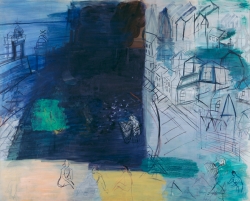
Raoul DUFY (1877-1953), Cargo noir, après 1948, oil on canvas, 126.7 x 158.7 cm. . © Centre Pompidou, MNAM-CCI, Dist. RMN-Grand Palais / Adam Rzepka © ADAGP, Paris, 2017
In the early years of the twentieth century, the influence of Impressionism was still strongly felt in Le Havre. In 1900, two years after Eugène Boudin’s death, the contents of his studio were donated to the city’s museum. Monet was living in Giverny and Le Havre’s great private collections contained works by him. Local politicians had hopes that the museum collections would also include a Monet one day. Pissarro summered in Le Havre in 1903, and the museum acquired two views of the harbour painted during his stay.
Of course, Dufy was steeped in this history. But he was also searching for himself. His first paintings were of the city, the harbour and the beach. In 1901, he had a work entitled End of the Day in Le Havre in the Salon des Artistes français. Much was at stake: it was the first time he had offered his work up for criticism. Before painting the full-size picture, he made drawings and studies in paint. But he made no attempt to please with the subject. Dufy chose to represent the least picturesque part of the harbour, the Quai Colbert, also known as the coal quay, at the time when the dockers went home after their day’s work. In dark, earthy colours, he painted the muddy quay, the coal-heaps, the workmen stooped with fatigue, the black plumes of smoke from the steamers’ funnels and the earliest electric cranes, which had recently been installed. Like Monet, Dufy depicted a real industrial setting, but his proximity to the subject produced a much harsher effect. Whereas the rosy mist of the sunrise poetically transcended Monet’s depiction of the harbour, Dufy’s sunset primarily expressed the temporal reality of the end of a day’s work.
Dufy soon abandoned this sombre, realistic manner in favour of a lighter palette. Above all, after discovering Matisse’s works in 1905, he embarked on a radically different course. Fauvism offered a freedom with line and colour that was totally new to him. At the very moment when Impression: Sunrise was reproduced for the first time in a publication, in 1906, Dufy followed in Monet’s footsteps by taking lodgings on the Grand Quai, probably in furnished accommodation or in a hotel (the open Venetian blind can be seen in the Nantes picture) and painted what he could see from his window: the quay in the foreground, and the crook of the outer harbour. At this early stage, he was already using bright colours arbitrarily. From 1906 onwards, for Dufy, Le Havre’s centre of attraction shifted to the beach and the Boulevard Maritime (Sun Reflections on the Sea at Sainte-Adresse).
The sun, seen head-on at the different stages of its course until it finally disappears, becomes a genuine subject. But its depiction is no longer accompanied by the usual atmospheric effects. The feature Monet referred to as a “pretty red ball” during his time in London has become a purely decorative subject that can be associated with other meteorological “signs” such as clouds, rain or rainbows in the same picture as required.
At the end of his life, when he was a long way from Le Havre and the city of his childhood had largely been destroyed in the war, Dufy took his explorations of light to extremes in a final series: Black Cargo Ships. The artist “reconstructed” the Le Havre he knew. All his signature motifs were brought into play: bathing women, shrimp fishermen, the pointed roofs of Sainte-Adresse, the jetty at the harbour entrance, and in every picture, a smoking cargo ship on the skyline, sailing towards us. A streak of black running from top to bottom of the picture, like a scorch-mark. “At the zenith, the sun is black: we are dazzled; we can no longer see anything in front of us,” confided Dufy. In this series, he was playing with the theory that we are blinded by the sun. But the black ship’s ghostly presence makes it seem like a testament, as if the vessel were bringing news of a death - the death of the painter, which was to occur soon afterwards, in 1953.
In the Service of Clouds, Sylvestre Meinzer’s film

Sylvestre MEINZER, Vue du port en bleu, 2017, . Private collection. © Sylvestre Meinzer
To quote from Sylvestre Meinzer’s description of her project: “The painters were passionate observers of Le Havre - its shifting sky and weather conditions, the reflections in the harbour basins, the colours of dawn, the movements of the wind in sails and waves on the sand. They sought to transpose their impressions onto canvas using their paintbrushes. The film makes an anachronistic imaginative connection, using video to offer another interpretation of these intrinsically fleeting yet paradoxically unchanging light effects in a harbour setting that has been utterly transformed. Starting at dawn, with a tableau of the estuary gradually awakening, it takes in the harbour activities, the colours of the beach and the reflections in the Bassin Vauban, ending at night with the lit-up oil refineries alongside the Seine.”
Meinzer’s film consists of seven independent sequences. It takes us on a slow meander through the harbour, from the estuary to the beach. The sequences are introduced by title cards that appear to borrow directly from Impressionist pictures, in that almost all of them associate a place with a weather mood or light effect: “White Morning on the Estuary”; “Reflections in the Harbor”; “Containers, Twilight”; “Seawall in a Storm”; and “Night on the Canal”.
Meinzer’s Le Havre is truly contemporary, with its quays piled with containers, its factories, and so on. But her visual stances recall the aesthetic sensibility of the past - of early photography and modern art. The image acquires an additional layer of temporality.
Although the artist uses an HD digital video camera and exploits its possibilities to the full (for instance, the hypersensitivity of digital equipment makes it possible to obtain a very sharp picture at night), she simultaneously seeks to give a particular texture to the picture, a certain fuzziness that seems to blur shapes and lines and heighten colours and light. She does so not by manipulating the image at the post-production stage, but simply by manipulating the camera. Removing the lens from the digital camera and replacing it with a plastic lid with a hole pierced in it, fastened directly to the body of the camera, she adapts the primitive technique of pinhole photography to film, thereby inventing “digital pinhole photography”.
The alternation of HD sequences with sequences that are much more “antiquated” from a purely technical viewpoint gives the film a particular rhythm, as do the sounds and music. The film plunges into reverie or emerges from it, transporting the viewer into a temporal limbo between present and past, between today’s Le Havre and the memory of the first painters and photographers, to experiment with modern ways of seeing and imagining.
More +
Publications

Impression(s), soleil
Catalogue d’exposition
MuMa musée d’art moderne André Malraux, Le Havre, 10 septembre - 08 octobre 2017
Auteurs : Annette Haudiquet, Ian Warrell, Sylvie Aubenas, Isolde Pludermacher, Marianne Mathieu, Marina Ducrey, Sophie Krebs, Cyril Neyrat et Michaël Debris
Édition : Somogy Éditions d’art / MuMa Le Havre, 224 pages
ISBN : 978-2-7572-1291-2
Catalogue d’exposition
MuMa musée d’art moderne André Malraux, Le Havre, 10 septembre - 08 octobre 2017
Auteurs : Annette Haudiquet, Ian Warrell, Sylvie Aubenas, Isolde Pludermacher, Marianne Mathieu, Marina Ducrey, Sophie Krebs, Cyril Neyrat et Michaël Debris
Édition : Somogy Éditions d’art / MuMa Le Havre, 224 pages
ISBN : 978-2-7572-1291-2




